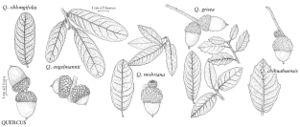Difference between revisions of "Quercus mohriana"
in Rydberg, Bull. New York Bot. Gard. 2: 219. 1901.
FNA>Volume Importer |
imported>Volume Importer |
||
| (6 intermediate revisions by 2 users not shown) | |||
| Line 1: | Line 1: | ||
{{Treatment/ID | {{Treatment/ID | ||
|accepted_name=Quercus mohriana | |accepted_name=Quercus mohriana | ||
| − | |accepted_authority=Buckley | + | |accepted_authority=Buckley |
|publications={{Treatment/Publication | |publications={{Treatment/Publication | ||
|title=in Rydberg, Bull. New York Bot. Gard. | |title=in Rydberg, Bull. New York Bot. Gard. | ||
| Line 10: | Line 10: | ||
|special_status={{Treatment/ID/Special_status | |special_status={{Treatment/ID/Special_status | ||
|code=F | |code=F | ||
| − | |label= | + | |label=Illustrated |
}} | }} | ||
|basionyms= | |basionyms= | ||
| Line 28: | Line 28: | ||
|elevation=600-2500 m | |elevation=600-2500 m | ||
|distribution=N.Mex.;Okla.;Tex.;Mexico (Coahuila). | |distribution=N.Mex.;Okla.;Tex.;Mexico (Coahuila). | ||
| − | |discussion=<p>Putative hybrids between Quercus mohriana Buckley and Q. grisea Liebmann are problematic and highly polymorphic. They are restricted to zones of contact between limestone, the preferred habitat of Q. mohriana, and igneous substrates, the preferred habitat of Q. grisea, or sometimes on dolomite, in western Texas.</p> | + | |discussion=<p>Putative hybrids between <i>Quercus mohriana</i> Buckley and <i>Q. grisea</i> Liebmann are problematic and highly polymorphic. They are restricted to zones of contact between limestone, the preferred habitat of <i>Q. mohriana</i>, and igneous substrates, the preferred habitat of <i>Q. grisea</i>, or sometimes on dolomite, in western Texas.</p> |
|tables= | |tables= | ||
|references= | |references= | ||
| Line 37: | Line 37: | ||
-->{{#Taxon: | -->{{#Taxon: | ||
name=Quercus mohriana | name=Quercus mohriana | ||
| − | + | |authority=Buckley | |
| − | |authority=Buckley | ||
|rank=species | |rank=species | ||
|parent rank=section | |parent rank=section | ||
| Line 51: | Line 50: | ||
|publication title=in Rydberg, Bull. New York Bot. Gard. | |publication title=in Rydberg, Bull. New York Bot. Gard. | ||
|publication year=1901 | |publication year=1901 | ||
| − | |special status= | + | |special status=Illustrated |
| − | |source xml=https:// | + | |source xml=https://bitbucket.org/aafc-mbb/fna-data-curation/src/2e0870ddd59836b60bcf96646a41e87ea5a5943a/coarse_grained_fna_xml/V3/V3_370.xml |
|genus=Quercus | |genus=Quercus | ||
|section=Quercus sect. Quercus | |section=Quercus sect. Quercus | ||
Latest revision as of 21:48, 5 November 2020
Shrubs or trees, evergreen or deciduous, shrubs erect, rhizomatous, trees small, 0.5-3 m. Bark pale, rough and deeply furrowed. Twigs yellowish or whitish, 1-2 mm diam., felty-tomentose. Buds dark red-brown, round-ovoid, 2 mm, glabrous, occasionally puberulent on outer scales, not subtended by persistent, hairy, subulate stipules. Leaves: petiole 2-5 mm. Leaf blade usually strongly bicolored, oblong or elliptic, (15-)30-50(-80) × (10-)20-30(-35) mm, leathery, base rounded, rarely cuneate or cordulate, margins entire or toothed or denticulate, undulate or flat, secondary veins 8-9 on each side, apex rounded or acute; surfaces abaxially densely gray- or white-tomentose with semi-erect curly, stellate hairs, secondary veins rather prominently raised, adaxially dark or dull green, lustrous or somewhat glaucous, with minute, scattered, semi-erect or appressed-stellate, (4-)6 or many rayed hairs, not felty to touch, secondary veins slightly raised or prominent within depressions. Acorns solitary or paired, subsessile or peduncle sometimes 10-15 mm, tomentose like twigs; cup shallowly to very deeply cup-shaped, 5-12 mm deep × 8-18 mm wide, enclosing 1/2 nut, base rounded or flat, margin thin, scales triangular-ovate to oblong, proximal scales coarsely tuberculate and canescent-tomentose, distal ones usually elongate and narrowed, tips appressed, reddish, thin, nearly glabrous; nut light brown, ellipsoid to ovoid, 8-15 × 5-12 mm. Cotyledons connate.
Phenology: Flowering spring.
Habitat: Limestone hills and slopes, calcareous substrates
Elevation: 600-2500 m
Distribution

N.Mex., Okla., Tex., Mexico (Coahuila).
Discussion
Putative hybrids between Quercus mohriana Buckley and Q. grisea Liebmann are problematic and highly polymorphic. They are restricted to zones of contact between limestone, the preferred habitat of Q. mohriana, and igneous substrates, the preferred habitat of Q. grisea, or sometimes on dolomite, in western Texas.
Selected References
None.
